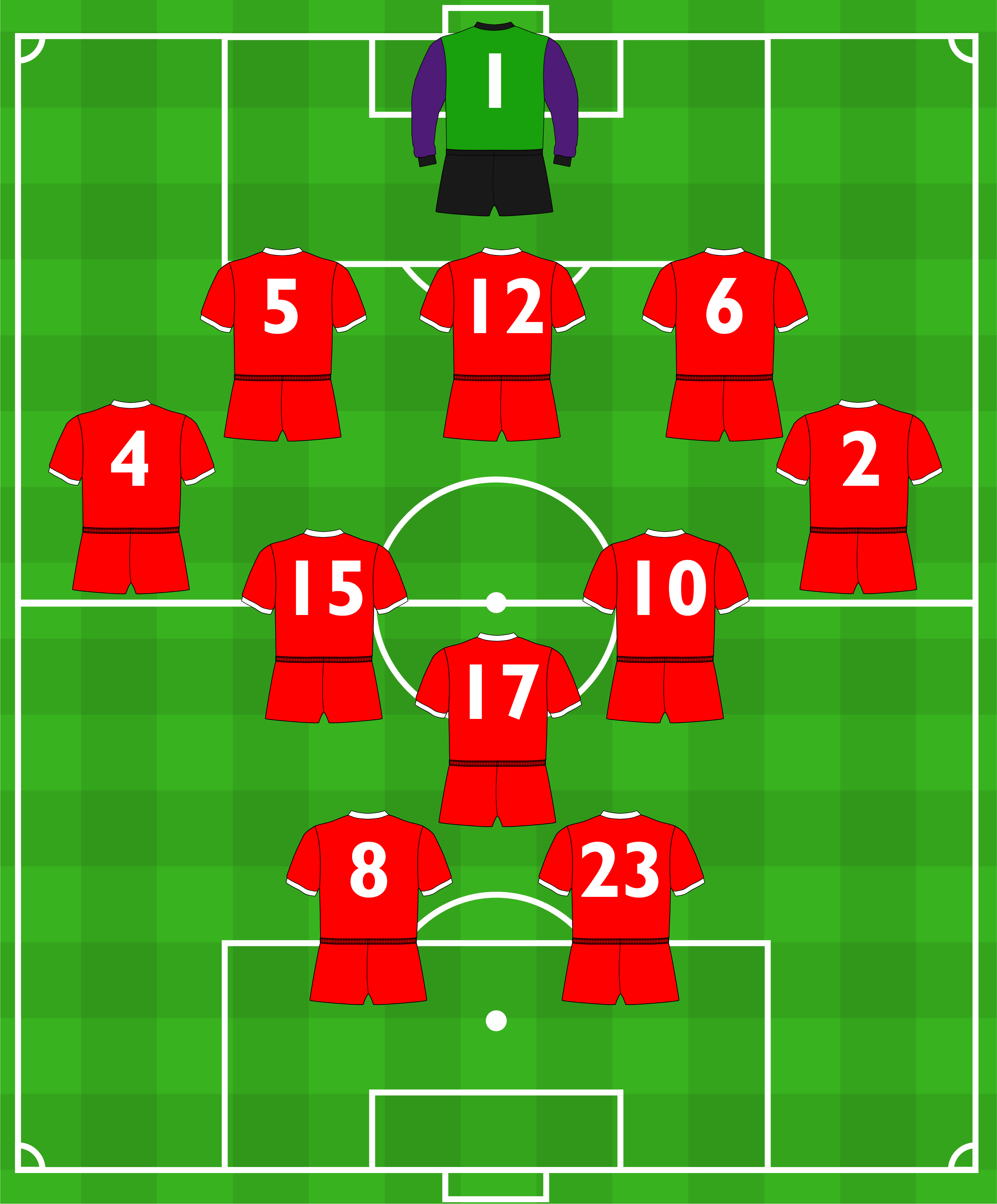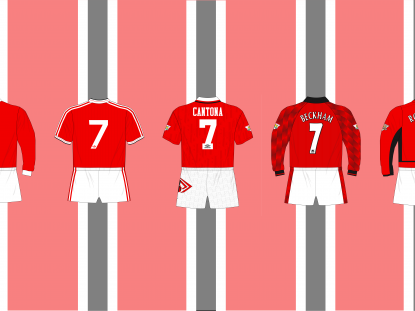We do enjoy when clubs ‘tidy up’ their numbers, i.e. the re-assignment of first-teamers with higher numbers.
As the days of 1-11 fade further, there is less of this re-allocation of numbers, with most one-off instances pushed by the player in question. In 1996, though, there was still a culture of wanting something close to the first 11 in the lowest numbers and the two biggest clubs in England effected big alterations. Perhaps it’s unsurprising, given that Liverpool and Manchester United are already responsible for two of the widest-ranging articles on this site (here for Liverpool’s unique numbering system of the 70s-90s and here for the story of the United number 7).
In the spring of ’96, an Eric Cantona-inspired United were reeling in Newcastle United in the Premier League title race, while Liverpool – using what Johnny Giles had described as “a three-man back four” – were playing some exellent stuff, eventually winding up in third place in the table.
The clubs also made it to the FA Cup final, with Cantona’s goal giving United a 1-0 win to clinch the double. It is, to be fair, worth noting that that goal came in the 85th minute, and had more to do with David James’ uncertain goalkeeping than Liverpool’s choice of pre-match attire.
These are the way the sides lined out for the final (Liverpool wore a green-and-white quartered change kit but representing that would make the numbers harder to see, which is, after all, the point of the whole thing):


With both goalkeepers wearing 1, between them the sides had nine players numbered above 11, but, if the same two line-ups had met three months later, there would have been just two offenders.
*

Let’s start with Liverpool. When Roy Evans decided to switch to a 3-5-2, it meant that Mark Wright (5) and Phil Babb (6) were joined by John Scales (12). Ideally, he would have taken 4 but Jason McAteer, playing right wing-back, had that, with number 2 Rob Jones switching to the left flank. Therefore, it made sense to give Scales 3, which had been vacant since Julian Dicks re-joined West Ham United during 1994-95.
In midfield, Jamie Redknapp, John Barnes and Steve McManaman somehow made an effective trio, despite the seeming lack of defending/attacking balance. Obviously, Barnes had been 10 since joining at the start of 1987-88, and 7 and 11 were empty after the departures of Nigel Clough and Mark Walters respectively. Looking at it objectively, Redknapp might have been a better fit for 7 but, given its mythology at Anfield, it made sense for McManaman to take that with Redknapp in 11.
The other switch was the most straightforward. Robbie Fowler had been 23 since his breakthrough in 1993-94, but with Ian Rush leaving after the final, Fowler to 9 was a no-brainer. More satisfying still was the re-tooling didn’t stop with the first XI, as Steve Harkness – whose brief loan spell with Hudderfield should have had more headline-love – moved from 22 to the 12 vacated by Scales, and Neil Ruddock swapped 25 for 14.
Sadly, the cup final side never played together again and we were robbed of seeing the 1-11 in action. Redknapp and Jones both suffered with injuries – the latter only made two appearances in 1996-97 – while Scales was sold to Tottenham.
*
 In the first three seasons in the squad-number era, none of the Manchester United 1-11 numbers had been worn by more than one player in the league. However, 8 and 10 lay idle for 95-96 after Paul Ince and Mark Hughes left, and in the summer of ’95 Alex Ferguson had a mini clean-up – Gary Neville moved from 27 to 20, Paul Scholes from 24 to 22 and David Beckham from 28 to 24. All three were key components of the double-winning side, though Neville and Scholes were on the bench in the cup final – Neville’s place taken by his brother Philip with Denis Irwin moving across to right-back.
In the first three seasons in the squad-number era, none of the Manchester United 1-11 numbers had been worn by more than one player in the league. However, 8 and 10 lay idle for 95-96 after Paul Ince and Mark Hughes left, and in the summer of ’95 Alex Ferguson had a mini clean-up – Gary Neville moved from 27 to 20, Paul Scholes from 24 to 22 and David Beckham from 28 to 24. All three were key components of the double-winning side, though Neville and Scholes were on the bench in the cup final – Neville’s place taken by his brother Philip with Denis Irwin moving across to right-back.
Gary Neville was still a first-choice for England during Euro 96 and there was never any likelihood of his staying out of the United team for long, so when Paul Parker left that summer, he was the natural choice for the number 2 shirt. Club captain Steve Bruce also departed, so David May switched from 12 to Bruce’s 4, with Philip Neville taking 12. The younger Neville had previously been 23.
Nicky Butt, 19 for the previous three years, move to take Ince’s old number 8 shirt while Beckham was given 10. The only instance of a 1-11 player being moved to accommodate a change was Brian McClair switching from 9 to 13 to allow Andy Cole inherit it. He had previously been 17 and, perhaps strangely, this was now given to new reserve goalkeeper Raimond van der Gouw.
Scholes made another move, from 22 to 18, in a straight swap with Simon Davies (this one, not that one), indicating the contrasting directions they were heading. New signing Ronny Johnsen took over the number 19, but in the Champions League he wore 5, following Lee Sharpe’s transfer to Leeds United, and would take it over permanently from 1997-98 on. Also wearing different numbers in Europe were Scholes and Phil Neville, 12 and 28 respectively. Basically, it was to do with UEFA’s rules on ‘A’- and ‘B’-listed players.
Ben Thornley (29 to 23) and John O’Kane (30 to 24) completed the downward movements. The one notable exception was Roy Keane, who kept 16 when taking 5 on Sharpe’s exit would have seemed expected. Apparently, he was later offered 7 by Ferguson but declined as having a higher number kept him motivated to prove himself.
His status as one of the first names on the teamsheet, and the lack of a number 5 in the league, meant that opportunities for United to play 1-11 were limited. The closest they came was in the first leg of the Champions League quarter-final at home to Porto when, with Keane absent, Ferguson went with a very adventurous side and was rewarded with a 4-0 victory.







5 Comments
If memory serves me right, Robbie Fowler switched from 23 to 12 during the pre-season between 1993/1994 & 1994/1995. Liverpool had just launched their gold 3rd kit and on Merseyside, those amongst the first to buy it, got FOWLER 12 on the back. Within a week or so Fowler decided against the switch and returned to 23, leaving hundreds of fans with a botched shirt. Liverpool said they’d replace the shirt for free so long as it was purchased at the souvenir shop at Anfield, but many had their shirts printed elsewhere and were left with the oddity. Liverpool then pledged to announce any future squad number changes prior to any new kit launches.
The same pre-season also saw reserve player Ashley Neal (son of Phil) issued with the 26 shirt and bizarrely un-issued within the space of weeks due to injury.
I’d like to know how many Liverpool gold 3rd kits are in circulation with SCALES 12 on the back have elements of FOWLER underneath? Given the schoolyard embarrassment many kids faced, parents who didn’t purchase the kit from Anfield decided to manually pick off the FOWLER letters and have SCALES added above the base glue upon Scales arrival at Anfield.
Wouldn’t be the absolute worst but in that situation I’d have gone for 19 or 22 and then waited until 7, 8, 10 or 11 became free.
Though I did once give Stefano Fiore number 6 at Roma when the next highest free was about 28
Depends how wrong it is! A left-back wearing 9, for example, would be hard to beat.
I can live with first-choice players wearing higher numbers once they’re not *too* high but it’s all quite subjective – for instance, Gianfranco Zola wearing 25 felt okay but I dislike John Terry wearing 26, perhaps the fact that he’s captain makes me think he should have taken 5 or 6.
What about when there’s a new signing and only a poorly fitting 1-11 number is free?
I’ve recently signed Gareth Bale, and I was mulling over whether he should get 3, 12, 19 or 22.
3 for my right winger doesn’t look right, but he used to be a left back, so I thought an exception could be begrudgingly made…
What’s the lesser of the two evils in your eyes: a first-choice player having a number >11, or a ‘wrong’ 2-11 number?